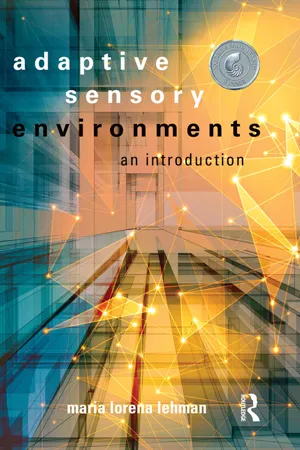
- 188 pages
- English
- ePUB (mobile friendly)
- Available on iOS & Android
About this book
***WINNER OF A NAUTILUS 2017 SILVER MEDAL BOOK AWARD***
Adaptive Sensory Environments: An Introduction presents a cutting-edge methodology for adaptive sensory design by fostering an inter-disciplinary approach in which aspects of neuroscience, biophilia, captology, nanotechnology, kinetics, and sensemaking all play critical roles in helping adaptive architecture "tune" to occupants. Furthermore, the book illustrates how adaptive sensory environments transform and uplift quality of life in entirely new ways, by strategically unlocking the potential that technological innovations bring. By teaching scholars, researchers, practitioners, specialists, and consultants how to design architecture that guides what emerging interactive technology can do, it allows them to see deeper into an architectural design, to extend beyond interaction and, ultimately, to build environments that adapt by changing and growing with their occupants' immediate needs and long-term goals.
Frequently asked questions
- Essential is ideal for learners and professionals who enjoy exploring a wide range of subjects. Access the Essential Library with 800,000+ trusted titles and best-sellers across business, personal growth, and the humanities. Includes unlimited reading time and Standard Read Aloud voice.
- Complete: Perfect for advanced learners and researchers needing full, unrestricted access. Unlock 1.4M+ books across hundreds of subjects, including academic and specialized titles. The Complete Plan also includes advanced features like Premium Read Aloud and Research Assistant.
Please note we cannot support devices running on iOS 13 and Android 7 or earlier. Learn more about using the app.
Information
Table of contents
- Cover
- Half Title
- Title Page
- Copyright Page
- Dedication
- Table of Contents
- Acknowledgments
- List of figures
- Introduction
- 1 Counter-productive design: what to improve
- 2 Living information: what to integrate
- 3 Kinetic frontiers: what to explore
- 4 Unfolding transience: how we evolve
- 5 Spatial dynamics: where to begin
- 6 Building perceptions: what to learn
- 7 Design for the senses: what to apply
- 8 Architecture that learns: what we can achieve
- 9 Architecture that teaches: how architecture influences
- 10 Plasticity for growth: what paradigm to build
- 11 Nano possibilities: what facilitates progress
- 12 Building personalization: what effect we want
- 13 Influence by design: when to be aware
- 14 Transformation to fulfillment: how to guide complex change
- 15 Authoring adaptive systems: how to see further into experience
- 16 Integrating nature: what is essential
- 17 Overarching goals: what to envision
- 18 Success factors: how to nurture growth
- 19 Collective behaviors: why scalability matters
- 20 Network communication: how to cultivate a self-aware citizen
- 21 Design process: how to further insight
- 22 Design capabilities: how to create the “bridge”
- 23 Spirit of place: how to connect with the soul
- 24 Future impact: what to target
- Bonus resources
- Bibliography
- Index